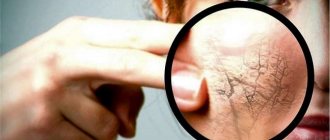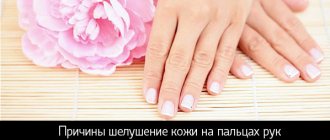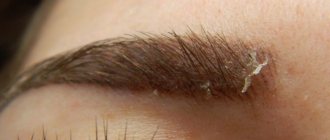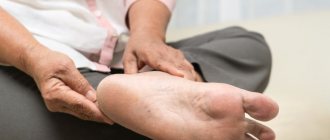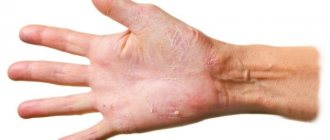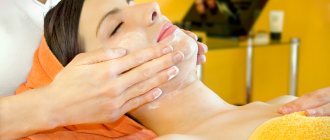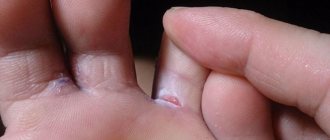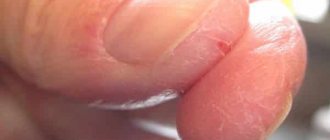Why does the skin between my toes peel?
Deterioration of the skin condition in the interdigital area can be caused by non-compliance with personal hygiene rules, vitamin deficiency, taking certain medications, and excess weight. But often such a sign indicates a malfunction of organs and systems, the presence of infectious and endocrine diseases.
Why peeling occurs:
- Diabetes mellitus - small and then large bleeding cracks appear on the pads of the fingers and between them.
- Shingles - severely peeling, peeling off the skin in the interdigital space.
- Eczema is accompanied by different types of rashes - blisters, scales, erosions, rashes. As the disease develops, itching, severe redness, inflammation occurs, and the capillaries become more noticeable.
- Allergies to medications, food, hygiene products, and cosmetics can manifest themselves in the form of itching, peeling, redness, and dense crusts between the toes.
- Skin dermatitis - inflammatory processes provoke the appearance of excessive dryness of the skin, it begins to crack, swell, peel off, and itches very much.
- Hyperhidrosis of the feet - increased sweating provokes the active growth of pathogenic microflora, inflammation occurs, the skin cracks and peels off.
Excessive sweating of the feet can cause peeling
Shoes and socks made of synthetic materials almost always cause the appearance of flaky areas - the skin cannot breathe normally, becomes wet, and begins to rot, which negatively affects the condition of the epidermis.
Peeling often occurs during the hot season - increased air temperature leads to dehydration, cracks appear, and the skin begins to peel off.
Fungal skin lesions
Fungal infections are one of the main causes of wounds and peeling and detachment of the skin in the interdigital space. With mycoses, an unpleasant odor of the feet, burning, itching, and pain appear. The disease is accompanied by a deterioration in the condition of one or more nails - the plate becomes cloudy, its color, thickness and structure change, all these symptoms are clearly visible in the photo.
Fungal infections are a common cause of peeling and sores between the toes.
Types and fungal infections:
- Athlete's foot - cracks appear on the heels and between the toes, the skin is very itchy and flaky, redness and a characteristic unpleasant odor appear. Infection occurs in public places.
- Rubromycosis - the disease manifests itself in the form of burning, weeping ulcers, itching in the interdigital area. As the pathology develops, the skin begins to peel off and the wounds bleed.
- Candidiasis. Sometimes yeast fungi settle on the skin of the feet - the epidermis begins to dry out very much, peel off, and wounds appear between the toes.
Important!
Unpleasant signs cannot be ignored; fungal infections develop very quickly, and soon the disease can cover the entire foot. If you suspect a mycosis infection, you should visit a dermatologist or mycologist.
Yellowish-brown streaks or spots on the nails
Signal: fungus
This very common foot disease is insidious in that it can be difficult to recognize right away, but if left unchecked, it can cause pain, serious damage, and even complete destruction of the nails. The fact that the nails turn yellow (often starting from the sides, gradually spreading to the entire plate) is considered one of the early signs. Moreover, the thickness and shine of the nail in some forms of fungus may remain the same, which is confusing. So if you notice yellowness, it’s better not to delay treatment.
Treatment methods
At the first appearance of peeling on the fingers, the feet need to be put in order. You will need medicinal baths, cleansing procedures, compresses, moisturizing creams, healing ointments.
Ointments and creams
Cosmetic foot creams are effective for dry epidermis. It is necessary to apply to the sole of the foot every evening, after steaming the skin in the bath and removing dead particles with a pumice stone or grater.
Oil solutions of vitamin A, E, purchased at a pharmacy, can replace foot cream. Aevit has proven itself well. It is recommended to take it orally as a course and use it to apply the drug to affected skin.
Bepanten, calendula ointment, salicylic ointment, Balzamed, Radevit are products that tend to deeply moisturize the dermis, help rapid regeneration, accelerate wound healing, and epithelization of damaged areas.
Baths and compresses
Baths and compresses help get rid of peeling. Use should be a course, and not occasionally. To heal peeling skin, you need to devote time to water treatments every evening before bed. Folk bath recipes are simple, prepared from inexpensive ingredients found in the house.
Herbal infusion baths are popular because of their effectiveness. Calendula, oak bark, chamomile, and nettle have a lot of medicinal properties. They relieve inflammation, pain, soothe the skin, and disinfect. The procedure lasts 20-30 minutes, after which the stratum corneum is removed using a scrub and a gentle file.
Baths soften the skin with the addition of the following ingredients:
- sea or regular table salt;
- 2 tablespoons of soda and liquid soap;
- apple cider vinegar 5%, which can be combined with glycerin, salt, lemon juice or soda. It is not recommended to use ordinary table vinegar; the effect on the skin is aggressive.
After steaming and treating with pumice, the feet and heels are wiped dry and a compress is prepared. Egg compress: add 2 egg yolks to heated olive oil (100 ml), then beat the mixture until smooth. The composition is spread on the feet, wrapped in film, and socks are put on. After 30 minutes, the feet are washed under running water. After the procedure, moisturizer is applied to dry feet.
A starch compress is prepared using 100 ml of chamomile decoction. Pour 2 teaspoons of starch into the herbal decoction and add 2 teaspoons of salicylic ointment. Stir the finished product and apply to the feet affected by peeling. After 30 minutes, rinse the compress with water. Moisturizing the skin with foot cream after using the compress is advisable.
72% laundry soap - a hypoallergenic, environmentally friendly product, which contains sodium or potassium salt, fatty acids - is used for the prevention and treatment of the skin of the feet. The soap is ground on a grater and applied to the feet or rubbed well on the skin. The compress is left overnight and washed off with water in the morning.
Medicines
When the skin between the toes begins to peel, itching, redness of the dermis between the toes, and painful cracks appear—a fungus appears. Baths and compresses will not help get rid of the defect. Mycoses can be caused by different types of fungi and affect the skin between the fingers and nails. The nail plates thicken and turn black.
If the first signs of a fungal infection appear, you should consult a doctor immediately. The dermatologist will prescribe tests and conduct an examination. In the early stages of the disease, it is much easier to extinguish the source of infection. Today, pharmaceutical companies offer a huge selection of medications aimed at suppressing the synthesis of certain types of fungi.
Medicines to help get rid of peeling skin on the toes:
- Lamisil;
- Batrafen, Lotseril, Demicten varnishes;
- Mycozolon;
- Exoderil;
- Mycoderil;
- Bifosin;
- Lamisil;
- salicylic ointment;
- Fungoterbin.
Treatment of fungus with medications lasts from 14 days to 3 months. Cases of relapse are possible. To prevent the disease from returning, the skin between the toes does not begin to peel off and itch again, for preventive purposes it is recommended to use ointment, cream, varnish or spray every six months.
https://youtube.com/watch?v=hKIJbl_tTZw
How to treat?
To eliminate unpleasant symptoms at home, you can use traditional methods, creams and ointments based on natural ingredients and oils, but if the condition does not improve within 3-4 days, you should visit a dermatologist.
Drugs
The choice of drug depends on the disease that caused excessive dryness and cracking of the skin. Treatment is aimed at eliminating itching, inflammation, destroying pathogenic microorganisms, and accelerating the regeneration process.
How to treat peeling skin:
- Miconazole, Terbinafine - external agents for the treatment of athlete's foot, they should be used twice a day for a week;
- Nizoral, Mycozoral - antifungal agents for the treatment of rubromycosis;
- Itraconazole, Ketoconazole - antimycotic agents for the treatment of interdigital mycoses caused by fungi of the genus Candida;
- Orungal, Fluconazole - tablets with an antifungal effect, prescribed for moderate and advanced forms of mycosis;
- Betadine, Shostakovsky ointment - moisturizes the skin well and promotes rapid healing;
- SixtuMed is a remedy for the treatment of cracks and peeling of the skin in diabetics.
Nizoral is an effective treatment for fungus
When diagnosing allergies, antihistamines are prescribed - Suprastin, Kestin. To treat eczema, hormonal ointments are needed - Prednisolone, Trimistin.
Folk remedies
Traditional methods will help eliminate itching and flaking of the skin; they can be used as first aid. Include in complex therapy for the treatment of dermatological diseases.
Therapeutic bath to moisturize and cleanse the skin
Mix 5 g of soda, 10 g of salt, 3-4 drops of tea tree oil, dissolve the mixture in 1 liter of warm water. Immerse your feet for a quarter of an hour, sting the top layer of the epidermis with a scrub or pumice stone, and rinse your feet with cool water. Dry, apply moisturizer or medicinal ointment. Carry out sessions until the unpleasant symptoms completely disappear; for prevention, you can do the procedure 1-2 times a week.
Baths with baking soda, salt and oils are good for getting rid of flaking.
Steam baths
If the skin becomes very inflamed, bursts and peels, steam baths will help. Boil 1 liter of water in a small saucepan, add 30 g of chopped hops or chamomile. Place the affected limb over the container and cover with a thick towel. Carry out the procedure for 10 minutes every other day.
Steam baths are good for your feet
Ammonia
If the skin between the fingers is affected by a fungus, ammonia will help - dilute 15 ml of ammonia in 200 ml of water, moisten a piece of thin natural fabric in the solution, and wrap the affected limb. Put a plastic bag and a thin sock on top. The compress should be done before bedtime. To improve the condition, 10–12 procedures will be required.
Ammonia fights fungal infections
Oil wraps
An excellent product for nourishing and moisturizing the epidermis. Heat 100 ml of castor or any vegetable oil in a water bath to a temperature of 40 degrees, add 4 quail yolks. Mix. Apply the mixture to the feet, between the toes, put on plastic bags, and on top - thin socks made of natural materials. After 45 minutes, remove the compress, rinse your feet with cool water, dry well, and apply a moisturizer.
Healing oils will moisturize the skin on your feet
What to do if a child has peeling skin?
If your child has peeling and peeling skin between his fingers, you should consult a dermatologist. When diagnosing a fungal infection, the doctor will prescribe safe antifungal drugs - Exoderil, Terbizil, multivitamin complexes to strengthen the immune system. If other dermatological problems are identified, antihistamines, anti-inflammatory, and antipruritic agents for external use may be prescribed.
Exoderil can be used for children
If a child has peeling skin not only between the toes, but also between the hands, it is necessary to urgently check the blood sugar level. Such symptoms are often the first sign of diabetes in children.
What to do if the skin of your legs peels off
To eliminate unpleasant symptoms, a number of measures are necessary to restore the functioning of the integument. Home care is one of the most preferred options among women.
No. 1 Mix the yolk of one egg with 1 tsp. butter. Add 2 tsp. grated potatoes and baby cream. Apply the mixture to pre-steamed skin and wrap with cling film and a warm towel. Remove the compress after 20 minutes. Repeat twice a week.
No. 2 A mint bath will help get rid of dryness and restore skin tone. To prepare it, you need to grind dry mint and mix it in equal proportions with calendula and chamomile herbs. Pour 1 liter. boiling water, leave to infuse for several hours. Pass the broth through a sieve and add to warm water.
No. 3 Heat 2 tbsp in a steam bath. spoons of honey. Combine with the same amount of olive oil. Dry skin is treated, every crack and wound. Leave the mask on for 20 minutes and rinse with warm water.
The most popular of them:
- Extra. This cream will give freshness, disinfect, prevent fungus and unpleasant odor.
- Gehwol drug. Maintains water-lipid balance, suitable for sensitive skin.
- Refreshing balm. A good helper for outdoor enthusiasts. Relieves itching, refreshes, improves blood flow.
- Akriderm. Heel syndrome relieves ointment and cream. They relieve itching, eliminate allergies, inflammation and swelling.
If no infectious disease is detected, the doctor may prescribe vitamins.
If your heels are peeling, and not a single folk method helps, it’s time to go to a beauty salon. Professional treatment will bring quick results.
The specialist will perform peeling, which helps the keratinization to peel off. This is necessary so that new healthy skin can form on the damaged skin.
Peeling and cracking skin does not look aesthetically pleasing and causes a lot of unpleasant sensations. A good way to prevent or get rid of such phenomena is wrapping. The most effective and popular types of this procedure include the following:
- Heat sunflower oil (100 g) in a water bath, add two yolks to it, and mix thoroughly. Lubricate the skin of your feet with the resulting warm mixture, then wrap this area in plastic wrap and put on warm socks. The duration of the procedure is 1 hour. With its help, the skin will be well and long lastingly moisturized.
- Make a paste from two tablespoons of potato starch and a small amount of water and mix it with a pre-made mixture of nourishing cream (3 tablespoons) and chamomile decoction (50 g). It is good to lubricate the problem areas with the product and, wrapping them with film, leave for half an hour. After this time, the product can be washed off. This procedure nourishes and soothes the skin well.
- Mix beet juices (50 g) and carrots (50 g) with nourishing cream (2 tbsp.). Then the resulting mixture should be applied to the feet and toes, wrapped in plastic wrap and waited for 30 minutes. At the end of the procedure, you should take a shower. This wrap nourishes the skin with vitamins.
If you have a problem with peeling feet, you should never ignore it.
It is very important to find out the cause of its occurrence and try to get rid of it as quickly as possible so that the situation does not worsen. Doctor’s consultations, drug treatment and effective folk remedies will help with this.
Causes of itching and peeling between toes
The skin of the foot becomes affected and cracks due to fungal diseases (dermatomycosis). Typically, itching of the fingers and peeling appear asymmetrically - on one leg more than on the other.
Fungal spores land on the feet, penetrate through the shoots into the stratum corneum of the skin and feed on protein (keratin). Parasites secrete metabolic products and toxins that suppress local immunity, cause allergic reactions and inflammation.
There is an increased risk of contracting ringworm in people suffering from circulatory disorders in the legs and diabetes. The fungus also threatens those who sweat a lot and take antibiotics. People with weakened immune defenses are more susceptible to infection.
Cracks and peeling on the feet appear due to a deficiency of vitamins and zinc in the body. For normal metabolism in the skin, retinol, ascorbic acid, tocopherol, and B vitamins are necessary.
If discomfort in the toe area occurs due to allergies, then antihistamine drops Fenistil, Zyrtec or Zodak will help. They quickly eliminate itching and redness and act for 6–12 hours. Allergic reactions on the skin of the toes are caused by the materials from which socks, shoes, and floor coverings in the house are made.
Concave, lumpy nails, white spots, horizontal grooves
Signal: nail psoriasis
For most people, these symptoms are in addition to cutaneous psoriasis, a chronic autoimmune disease with characteristic external signs, but they can also occur independently. If you have never suffered from cutaneous psoriasis and have not damaged your nails with procedures such as extensions, but at the same time you are concerned about their fragility, peeling, roughening, changes in color or shape, small pits (like a thimble) and other mentioned signs, then it is better to check for the presence of this diseases. Like other autoimmune diseases, psoriasis is incurable, but with the help of modern means (creams, injections, etc.), as well as proper care, sustainable remission can be achieved.
Causes of peeling
For some reason, every person takes care of their face and takes care of it, but not their feet, and almost no one knows why the skin on their feet dries and peels. But in addition to the fact that such a defect looks unpleasant visually, it also causes a lot of discomfort in the form of scratching and tightening.
In order to quickly get rid of a sudden problem on the skin, it is necessary to find out the factor that provoked such an illness. There are four main groups, which include:
- negative external influence;
- unhealthy diet and allergies;
- age reasons;
- infectious lesions of the extremities.
Negative external influence
The skin on your heels and feet can become dry due to many factors. The main irritants are:
- The air in the apartment is too dry, especially in winter when the heating is on.
- Underwear, tights, socks made from artificial fabric, especially if there is a tightening effect. Such materials do not allow the skin to breathe normally, causing water imbalance.
- Ultraviolet rays can be very dehydrating, especially if people overuse tanning beds.
- Water with a high chlorine content, such as in a swimming pool, can also be quite drying to the skin.
https://youtube.com/watch?v=aE2zHczuRwk
Age-related thinning of the skin
The skin is designed in such a way that with age it begins to change, becomes thinner, loses much more moisture - all this leads to peeling. This is directly related to the disappearance of collagen fibers. Namely, they are engaged in the formation of the mass of the skin.
In turn, the water-lipid mantle simply ceases to cope with the load due to a decrease in the fluid that enters the skin, and this is also affected by disturbances in the secretion of sebum. These age-related changes become the reasons why the skin on the legs peels.
https://youtube.com/watch?v=hKIJbl_tTZw
Infectious and somatic diseases
As soon as a person develops any dermatological disease, the disease is immediately followed by a violation of the skin barrier. This is followed by loss of moisture, which is why the skin becomes dry, which leads to peeling. If the skin between your toes is peeling and itching or even cracking, it is most likely a fungal infection. In this case, only a dermatologist will help get rid of the problem, who, based on laboratory tests, will prescribe the appropriate treatment.
And also one of the reasons why the skin on the feet, calves and legs peels off can be diseases such as eczema, psoriasis and exfoliative dermatitis. In children, flaking and itching of the lower extremities can be caused by Kawasaki Syndrome. Self-treatment cannot be carried out, but to establish an accurate diagnosis it is better to consult a doctor.
https://youtube.com/watch?v=IBHGEPq-YGI
In addition to dermatological diseases that cause dry skin on the legs, there are a number of somatic ailments:
- cirrhosis of the liver;
- hepatitis;
- kidney diseases;
- diabetes.
It should be added that quite often such problems on the legs occur due to the use of steroid hormonal drugs, and even short-term use of such drugs causes dysfunction of the horny skin.
Unbalanced diet
One of the main factors why women's heels peel is pregnancy. This is due to hormonal imbalances, which cause the skin to peel and peel, and this can be quite painful.
People who have changes in their skin in the form of peeling should adjust their diet. Be sure to include vegetable oils, dishes with lots of vegetables, fresh fruits, fish dishes and seafood. With a lack of vitamins or vitamin deficiency, problems associated with peeling on the feet and fingers may also appear.
An allergic reaction is one of the main causes of skin irritation and, as a consequence, peeling. Moreover, irritants can be cosmetics, food consumed, synthetic clothing and much more.
Possible complications and necessary care
If you do not react in time to the fact that the epidermis on the legs has begun to peel off, interdigital peeling has formed, areas on the folds have turned red, there is a high probability of tissue infection by pathogenic microbes.
The appearance of eczema must be diagnosed by a dermatologist. It can be caused by fungal infections. Psoriasis appears on the skin and nails, occurs in waves with symptoms of itching, burning, peeling, irritation of the skin, and the appearance of papules that burst over time. The causes and pathogenesis of chronic disease are not fully understood by medicine. Studies have shown that the onset of the disease is preceded by infections caused by fungi and staphylococci. Self-treatment without traditional medicine can worsen the patient's condition.
Proper foot care will relieve discomfort and flaky feet. You need to spend a little time: prepare softening baths, apply a moisturizing nourishing cream every evening, choose your shoes more carefully and consult a doctor at the first sign of fungus.
The problem of peeling and peeling skin on the toes is common. It can occur in men and women, and even in children of different ages. Peeling causes discomfort, the legs have an unaesthetic appearance, and other, more unpleasant symptoms are often associated. They cannot be ignored, because the speed of their elimination depends on how quickly and correctly the causes of the condition are identified.
The skin on the legs can peel off in both adults and children. Increased dryness of the toes and feet is the main reason for this phenomenon. The most common factors causing the problem also include:
- 1. Uncomfortable shoes that an adult or child wears for a long time.
- 2. Socks and shoes made of synthetic materials.
- 3. Lack of vitamins in the body, especially A and E. In this case, the skin on the fingers peels off, hair and nails become brittle, and hair loss increases.
- 4. Allergic reaction.
- 5. Increased sweating of the feet (diseases of this nature cause great discomfort, especially for men).
- 6. Exposure to hard water.
- 7. Improper foot care or lack thereof.
- 8. A fungus that affects the fingers.
- 9. Severe stress, depression.
- 10. Exposure to too high or low temperatures, sudden transition from heat to cold and vice versa.
Treatment options
To improve the condition of the skin of the legs, you need to identify and eliminate the provoking factor. The choice of means and methods of therapy is determined by the condition of the epidermis and the reasons that caused such problems.
Drug therapy
If serious diseases are identified that provoke peeling, doctors prescribe medications:
- Why the skin on the elbows and knees peels and how to deal with it
- Antifungal drugs. Treatment usually begins with topical agents, and in more severe cases, oral tablets are prescribed. The most popular antifungal drugs are Lamisil, Clotrimazole, Nystatin, Exoderil.
- Antihistamines. If an allergic reaction develops or severe itching, the following medications are prescribed - Zodak, Suprastin, Cetrin, Fenistil.
- Local anti-inflammatory drugs. They help in the fight against irritation that leads to peeling. The most popular anti-inflammatory drugs are Bepanten, zinc ointment, Fenistil. In more severe cases, medications containing corticosteroids are prescribed. This is Lokoid, Advantan.
The use of folk remedies
The following homemade masks can be used to nourish the skin and normalize its condition:
- It is necessary to thoroughly mix two yolks and three tablespoons of slightly warmed vegetable oil. The resulting substance is applied to the feet and wrapped in polyethylene. After this, socks are put on your feet. The compress is kept for about an hour, and the procedure is repeated daily until a positive result is achieved.
- First you should prepare a chamomile infusion. Take a tablespoon of flowers per glass of boiling water. The liquid is filtered after 20 minutes. Mix 50 ml of the finished infusion with three tablespoons of any moisturizing cream, after which the first component of the remedy is ready. Next, two tablespoons of starch are diluted with plain water to obtain a creamy substance. The two mixtures are combined with each other and applied to problem areas of the skin. The limbs are wrapped in polyethylene and waited for half an hour. At the end of the procedure, the feet are washed in plain water and wiped dry.
- You need to take any fatty cream and mix it with a small amount of beet or carrot juice. The resulting product is applied to the areas of peeling, left for 40 minutes, then washed off.
Spoon nails
Signal: anemia, less often lupus
Is the nail plate so concave that it holds a drop of water? This phenomenon, known as koilonychia, may indicate iron deficiency or, conversely, excess iron accumulation in the body (hemochromatosis). And in some cases, such nail deformation is a sign of lupus, an autoimmune connective tissue disease. The doctor will determine the exact cause using a blood test. By the way, babies sometimes have spoon-shaped nails, but most often this is not a disease, and in the very first years everything returns to normal.

